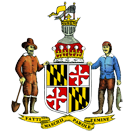| The items in this collection fall into three groupings and focus on three generations of the Galloway-Maxcy-Hughes families, the first consist primarily of deeds, business papers and letters between Joseph Galloway (1731-1803) and his sons, John Galloway, (d. 1810) who built Tulip Hill on the West River near Annapolis, Maryland c. 1755-56 and Samuel Galloway(1720-1785), and relate to their farming and shipping business. Of particular interest is (3), a letter dated October 21, 1774, which makes a reference to Anthony Stewart, owner of the just-burned Peggy Stewart (October 20) being kept from putting a handbill in the papers. Galloway states “This is Liberty with a Vengence.” This letter complements other Galloway materials which can be found in MSA SC 167 and MSA SC 125, which also discuss the burning of the Peggy Stewart.
The second group of materials revolve around Virgil Maxcy, (1785-1844) who married Mary Galloway, daughter and only child of John Galloway and Ann Chew, and who inherited Tulip Hill,. The majority of these are correspondence between Virgil Maxcy and Mrs. Maxcy. Later correspondence includes letters from their daughter Mary Maxcy. The earlier letters (16-28) offer a number of first-hand insights and comments on the War of 1812 in the vicinity of the Washington and Baltimore, and the political gossip of the time, and important social events such as Madison’s inauguration (27). Virgil Maxcy had a long-term relationship with John Calhoun, and there are references to “my old friend Calhoun” (both were originally from South Carolina); to going to see the President and to attending, in 1813, Madison’s inaugural. Of particular interest in this group is a first hand-account the “The Great Baltimore Riot of 1812” (19) and subsequent trials (23,24, 25, 26). He notes the death of Gen. James Lingan of Montgomery County, and the wounding of General Richard Henry (Light Horse Harry) Lee, who, at the time Maxcy wrote, was thought to have suffered a fatal wound” (Lee survived but never fully recovered.) In (21) Mrs. Galloway (mother of Mary Maxcy) notes possibility of having to evacuate because the British are possibly coming. An 1813 letter from Benjamin Chew, of Philadelphia, Mary Maxcy’s Uncle, makes derogatory reference Gallatin’s efforts in Russia. (28).
Subsequent correspondence references other Washington political events, and mentions figures such as Daniel Webster, Calhoun, Pinckney, Hayes, Buchanan and others. (35,40)
Family business, including gardening, and medicinal treatments can also be found in this correspondence, including illnesses, and some of young Mary Maxcy’s romantic life (29, 31,32, 34,38,41-46). Virgil Maxcy was U.S. Charge d'Affaires to Belgium, 1837-42, and he writes from their to his children about consulting a homeopathic physician(47).
Virgil Maxcy was one of five people killed in an explosion on the ship Princeton on February 28, 1844. President John Tyler was on board at the time, and narrowly escaped injury. Other deaths included the US Secretary of State. Maxcy and the other victims were laid out in the East Room of the White House, and Maxcy was subsequently buried at Poplar Hill. A letter to From Mary Markoe dated one day after the accident, recounts the accident, and notes that “Maxcy’s daughter was in Washington at the time.” (48)
The third group of materials begin in 1845 and relate to George Hughes, who married Sarah Maxcy. (50-79) Of particular interest is folder 53, a series of fifty-three letters from Francis Markoe,Hughes’ brother-in-law, and husband of Mary Maxcy, to George Hughes between Feb. 5, 1844-June 21, 1848. All but three are dated. The period of the correspondence covers the War with Mexico, and most of it involves topics relating to that event. It covers a broad range of military, and political events in Mexico and political controversies in Washington, including political disputes relating to Winfield Scott and Zachary Taylor’s leadership, promotional opportunities for Hughes, Kearney, the Fremont trial in California, the battles of Vera Cruz, Buena Vista and Agua Nueva, and Santa Ana. He reports on a secret plan by Polk to take charge of all the customs in Mexico. Markoe evidently published some letters from Hughes in the National Intelligencer, and there are reference to these. There are reports of several meetings with Jefferson Davis, whom Markoe seems to have known personally. Markoe was involved in creation of The National Institution for the Promotion of Science, and this correspondence refers to a meeting with Louis Agassiz to promote this idea.
Items 54-64 cover relate to George Hughes European 1853 efforts to promote the New York Industrial Exhibition. A letter from Juan N. Almonte to Major G.W. Hughes (66) relates to a proposed 1857 meeting by Hughes, then a topographical engineer, with the President of Mexico. Almonte notes that “your aim was mentioned to him confidentially by the President of the United States.”
Miscellaneous other items include a letter from Mrs. Francis Markoe to Mrs. George Hughes dated April 3, 1865, (67) reports on hearing that Richmond has been taken, concerns about her son Frank, and the statement, “I do not give the cause up, but God alone knows what they are to do now.” There is a political pamphlet relating to George Hughes (73), excerpts from the letters of Mrs. Henry Adams alluding to important Joshua Reynolds portraits once owned by Virgil Maxcy (77), genealogical notes relating to the Galloway and Chew families (69,78), a photo of George Hughes (74), and an undated inventory of Ann Chew Galloway’s property.
|
